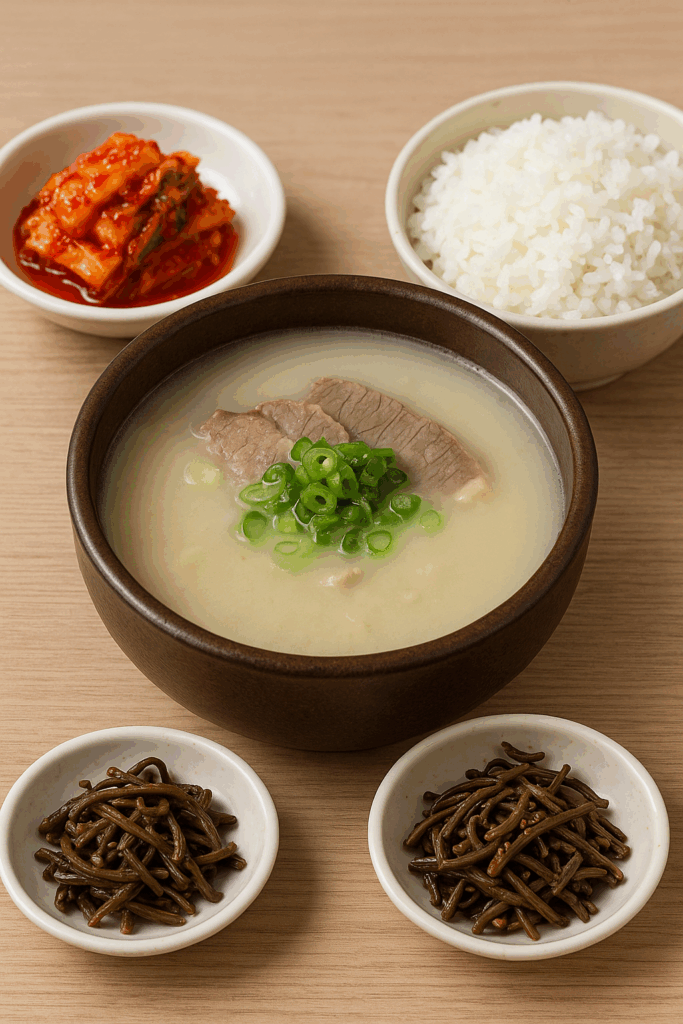🧪 Introduction: When Even Poison Becomes Food – The Philosophy of Korean Cooking
To understand Korean cuisine, we must ask:
“Why do Koreans eat plants like bracken, which are considered toxic in the West?”
This philosophy isn’t limited to food. In traditional Korean medicine (Hanbang), certain herbs with natural toxins are processed through techniques called poje (炮製) to neutralize their harm and enhance their benefits.
For example, Aconite (Buja) and Pinellia (Banha) are dangerous raw, but when boiled and dried properly, they transform into healing remedies.
This mindset extends to food as well:
👉 Bracken (gosari), classified as a carcinogen in the West, is a must-have side dish for Korean ancestral rites—after detoxification by boiling and drying.
👉 Gomtang, or beef bone soup, is made by slowly simmering beef bones, tendons, and intestines for hours, extracting every nutrient and transforming discarded parts into a deeply nourishing broth.
Korean cuisine isn’t about survival alone—
it’s about facing nature’s harshness and mastering it with cultural wisdom.

🥢 1. Did Korean Dishes Begin Because There Was Nothing to Eat?
Korean cuisine often features ingredients that might seem humble or even unusual:
Ox bones, wild greens, fermented pastes, and dried fish.
This isn’t just evidence of a frugal past, but a testament to how Koreans elevated even the simplest ingredients into culinary traditions.
🌿 2. Eaten in Korea, Feared in the West: Toxic Plants with Cultural Gaps
Here are common ingredients widely consumed in Korea but often avoided or considered toxic in the West:
| Plant Name | In Korea | In the West |
|---|---|---|
| Bracken fern (Gosari) | Boiled, dried, seasoned as namul (side dish) | Considered carcinogenic |
| Aralia (Dureup) | Spring delicacy, blanched and dipped in sauce | Potentially toxic if raw |
| Daylily (Wonschuri) | Boiled and seasoned | Raw consumption can cause nausea |
| Pinellia (Banha) | Herbal medicine | Mucosal irritant if raw |
| Burdock root (Ueong) | Used in pickles and side dishes | Rarely eaten, potential allergen |
| Smilax (Cheongmae) | Used in soups | Little culinary use |
| Water dropwort (Minari) | Used in soups and pancakes | Risk of contamination, not widely eaten raw |
🧪 Korean cuisine relies on boiling, drying, fermenting, and salting to neutralize natural toxins—a tradition often missing in Western culinary culture.
🍲 3. Scarcity Was Real, But It Wasn’t Just About Survival
Korea’s mountainous terrain and harsh winters did limit food variety.
But rather than settle for tasteless meals, Koreans found creative, healthful, and flavorful ways to thrive:
- Bracken became detoxified and nutritious
- Doenjang (fermented soybean paste) became a protein-rich superfood
- Kimchi became a symbol of life and preservation
🧂 4. From Scarcity to Culture
The real beauty of Korean food lies in how scarcity was transformed into community, flavor, and meaning.
Dishes like bibimbap gather leftovers into harmony,
Gomtang turns discarded bones into energy,
Doenjang ferments time itself into depth.
Let’s add two more icons of Korean culinary creativity: Samgyeopsal and Gopchang.
🥓 Samgyeopsal: Pork Belly, a Korean National Dish
Samgyeopsal (pork belly) is now Korea’s most popular grilled meat,
but in the West, pork belly was once a low-grade, fatty cut used only in processed meats like bacon or ham.
Korea flipped the script:
Grilling it at the table, dipping it in sauce, and wrapping it in fresh greens turned it into a shared ritual of joy and indulgence.
Today, samgyeopsal is a “no-special-occasion feast”—and a must-try for foreign visitors.
🐄 Gopchang: From Waste to Gourmet
Gopchang (beef or pork intestines) was long regarded in the West as waste or peasant food.
In Korea, it became a beloved street food: grilled, marinated, and even added to spicy stews.
Now, gopchang restaurants are gaining popularity abroad, and the dish has even appeared in Netflix food series as a Korean must-try.
Korea is perhaps the only country where the parts the world threw away became the soul of its cuisine.
💡 Conclusion: It May Have Started in Scarcity, But It Became Wisdom
Korean food may have begun in hard times,
but it evolved into a culture of resilience, creativity, and harmony with nature.
Rather than say, “They ate it because they had no choice,”
we might better say,
“They chose to make meaning and beauty from what others discarded.”